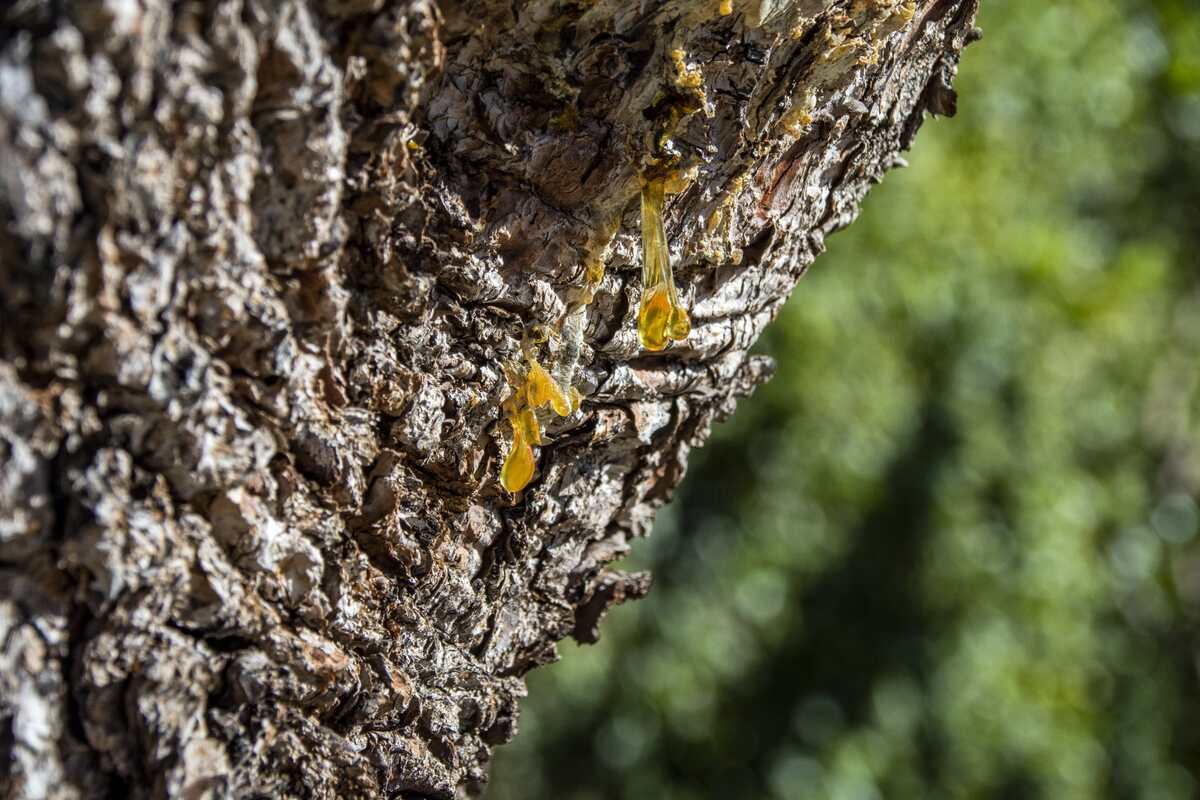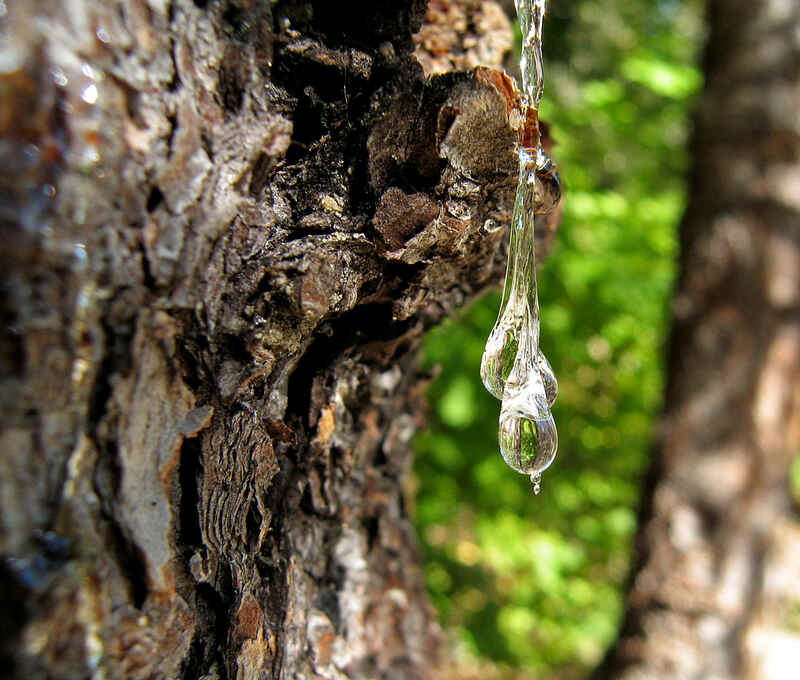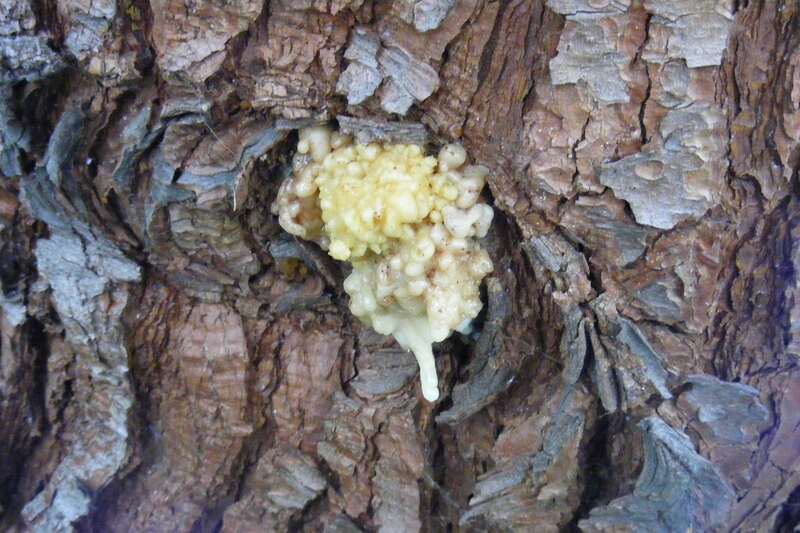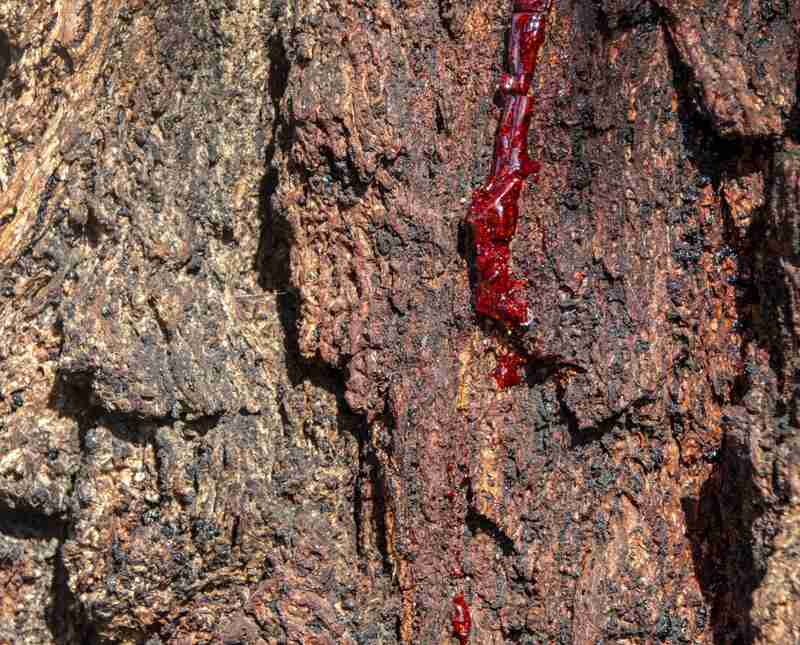
You might find yourself in a bit of a sticky situation when your tree bleeds sap. Some trees naturally have more sap, but there are many other reasons, like injury, that cause sap to leak from your tree.
Know if your tree is in distress, what’s causing sap to leak from your tree, how to treat it, and how to prevent it.
What is Tree Sap?

Sap is the lifeblood of a tree made of a sugary liquid filled with water, nutrients, and minerals that are transported throughout a tree via the phloem and xylem, much like blood moves through the human body. A tree can’t survive without sap.
The xylem moves water, minerals, and hormones in a long string formation from the base to the top of the tree. These channels die off yearly and a new formation is created. These are what are known as the rings in a tree trunk, one for every year of life.
Phloem is the sticky, sugary substance created through photosynthesis which feeds the tree and leaves throughout the growth period.
What Causes Excessive Sap to Drip From Trees?

Sap dripping from a tree could mean many things. Some trees, like maples, may be more prone to dripping sap than others, and not pruning them during the right season can cause quite a sticky mess. But there are other instances where a tree leaking sap could mean there are big problems that need to be addressed.
Pruning Damage
A properly pruned tree may seep out a small amount of sap. This isn’t a problem as long as it stops and the cut heals. But if sap continues leaking for an extended period of time or if it is excessive, then this could cause your tree to be susceptible to pests and disease, and could eventually lead to its death.
Good pruning practices are the best way to avoid excessive sap dripping from trees. Pruning during the right time of year, like when the tree is dormant, can be especially important when pruning trees known as “bleeders.”
Early summer pruning is recommended for these types of trees:
“Bleeder” Trees
- Maple
- Birch
- Honeylocust
- Chinese Wingnut
- Elm
- Magnolia
- Poplar
- Sumac
- Black Locust
- Dogwood
- European Hornbeam
- Walnut
- Willow
How to treat pruning damage: A properly pruned tree does not need any intervention. In fact, tree or pruning paint can make the problem worse. Rather than sealing out infections, wound dressings seal moisture inside the wound, creating decay. It is best to let your tree seal the wound and heal itself. If you are particularly concerned about your tree, call a certified arborist to evaluate your tree and recommend a plan of action.
How to prevent pruning damage: Always follow proper pruning practices to minimize damage by using quality tools, pruning during the best time of year for your particular tree, and performing the proper cuts.
Tree Wounds
Bacterial wet wood, also known as slime flux, can happen when there is an open wound on your tree. Slime flux typically occurs in the spring or fall when sap flow is at its peak. Slime flux is a result of a bacterial growth buildup causing fermentation, which leads to internal gas pressures. Eventually, the pressure and bacterial growth become too much, leading to the release of sap down the outside of the tree.
Due to the fermentation, the sap will have an alcoholic smell that may become sour over time. Secondary fungi, mold, or bacteria growth may occur within the sap creating a slimy texture on the bark.
Insects Attracted to Slime Flux
- Bees
- Wasps
- Yellow Jackets
- Beetles
- Butterflies
How to treat tree wounds: Slime flux isn’t curable, however, it should stop after a few weeks or months with no permanent tree damage. If you are concerned about your tree’s appearance, you can use a 10% bleach solution and water to clean stains off the bark.
How to prevent tree wounds: You won’t be able to prevent all tree wounds, but be careful when mowing or landscaping near your tree so you don’t inadvertently cause a wound. For wounds you can’t prevent, good tree care is always going to be the best way to help your tree recover from anything Mother Nature may throw its way.
Pest Damage
A tree with oozing sap may be an early sign of a bark beetle or other pest infestation. Producing an abundance of sap is a way your tree protects itself from pests. The sap will collect near the borehole in the bark creating a sticky mess known as a pitch tube. An otherwise healthy tree will be able to fend off an infestation, but a tree suffering from drought, mechanical injury, or excessive pruning will have a harder time protecting itself from pests.
How to treat pest damage: For pest issues, there are many factors that go into choosing the correct plan of action. For instance, the type of pest will be a major deciding factor on how to best treat your tree’s infestation, as well as the extent of the damage. Contact a certified tree specialist to properly identify your specific pest and recommend a treatment plan based on their analysis of your infestation.
How to prevent pest damage: The best line of defense against these annoying little pests is to keep your tree as healthy as possible. Your tree has a natural defense mechanism to fend off possible invaders, but with proper pruning, mulching, watering, and fertilizing you give your tree the best chance of survival.
Fungal Cankers
A tree with a leaking canker may be an early sign of disease. Fungal cankers are lesions on tree bark created by fungi or bacteria. These leaking cankers are often caused by the fungus phytophthora, which can cause dark brown sap to drip from cankers. If you see reddish-black sap, your tree may be suffering from sudden oak death which attacks not just oak trees but also bigleaf maples, some firs, as well as other plants. Sap oozing from cracks in infected bark is called gummosis and attacks fruit trees.
How to treat fungal cankers: Best practice is to prevent fungal cankers, as there is little you can do after they form on your tree. Unfortunately, there aren’t any chemical options available for treating fungal cankers. The only option is to prune the infected parts of the tree.
How to prevent fungal cankers: The best way to avoid tree cankers is to avoid stressing your tree. While you may not be able to predict or prevent stressors such as drought or wounds caused by a storm, regular mulching, pruning, watering, and fertilizing will give your tree the best chance of defending itself against these stressors.
Bacterial Cankers
Brenneria rubrifaciens is a bacteria that causes deep bark canker on walnut trees. The infection can be identified by the deep cracks in the bark where the sap is oozing. It will leave 1- to 2-foot-long reddish and dark brown streaks down the trunk. While not a lethal disease, it will reduce the amount of fruit produced and weaken the tree.
How to treat bacterial cankers: Remove weeds and grass from around the bottom of young trees to improve air circulation, and prune infected areas. Copper fungicides also can be used as part of a treatment plan.
How to prevent bacterial cankers: Good tree maintenance is the best way to arm your tree against bacterial cankers. Perform proper pruning practices during dormant seasons, and provide enough sun, fertilization, and water.
Pro tip: Be sure you disinfect your equipment after each cut to ensure you don’t spread the bacteria from tree to tree.
How Do I Get Rid of Leaking Sap?

Prune Your Tree
Cutting off small branches dripping sap may help stop sap from leaking. You want to make sure you prune during your tree’s dormant season or you may cause unnecessary stress, which could eventually kill your tree. Check with your local nursery about your specific tree species for the best time of year to prune with the least amount of risk of damage.
Apply Insecticides
Sap can attract numerous types of pests which could lead to an infestation and could ultimately kill your tree. An insecticide may help control any possible infestations, however, it is best to contact a certified arborist to evaluate, diagnose, and properly treat your tree, particularly when dealing with an infestation.
Have Patience
There isn’t a quick fix for a tree-dripping sap. There’s not much you can do other than wait and the sap should eventually stop dripping.
Does Leaking Sap Mean My Tree is Dying?
Maybe. If your tree is leaking sap, it might be a sign your tree is dying, but it won’t be the only symptom. If your tree is truly declining, there will be numerous other signs.
Symptoms of a Dying Tree
- Root damage
- Leaning tree
- Heaving soil
- Bark falling off
- Rot or fungus
- Bug infestation
- Open wounds
- Brittle branches and grounded sticks
- No leaves
- Black lesions on leaves
- Misshapen or discolored leaves
FAQ About Leaking Sap
There are a few different ways to remove sap from your car, but start with hand washing your car before trying any other method because some of the other methods can be risky if not done correctly.
1. Hand Wash: Get out the old bucket and sponge to hand wash your car ASAP. As convenient as automatic car washes are, in this case it could make the problem worse by spreading the sap. Pro Tip: Be sure you use hot water to help soften any dry sap.
2. Rubbing Alcohol: Soak a clean cloth in rubbing alcohol. Apply it directly to the tree sap area for 30 seconds. Check to see if the sap has softened. If you can’t yet rub it off with a cloth, apply the alcohol-soaked cloth for another 30 seconds. Gently wipe the softened wax away. Pour hot water directly onto the sap if needed, and wipe away. Pro Tip: Don’t leave the alcohol-soaked rag on too long. Alcohol can strip auto paint.
3. WD-40: You can spray WD-40 directly onto the sap and let it soak for 5 minutes. Add a cloth soaked in hot water for additional penetration, then wipe away. Repeat as needed, then wash with soap and water.
4. Baking Soda: Use baking soda and warm water to create a thick paste. Gently cover the sap with the paste, taking care not to scratch the paint. Let it sit for a few minutes then pour boiling water over the sap and baking soda, then wipe away.
5. Bug and Tar Remover: You also can use bug and tar remover as it is formulated with powerful solvents to break down tough stains.
While all trees produce sap, not all produce edible sap. Naturally, we all know maple syrup comes from maple trees, but there are other trees that produce edible sap. However, not all edible tree sap will be sweet and tasty. It may taste bitter, bland, or even tasteless.
Trees that Produce Edible Sap
● Walnut
● Heartnut
● Gorosoe
● Sycamore
● Ironwood
● Birch
● Pine
● Fruit
● Linden
● Alder
Typically it is best to prune these trees in the early summer once the leaves have hardened or turned dark green. You will likely still see sap leak from these trees, but they won’t leak excessively.
Dealing With a Sticky Situation?
Are you still unsure if your tree has a problem or how to fix it? Let us help connect you with a certified tree specialist who can evaluate, diagnose, and treat your tree.
Main Image Credit: PublicDomainPictures